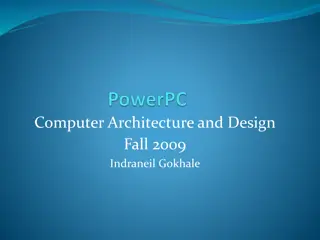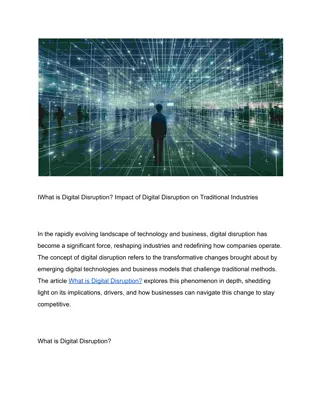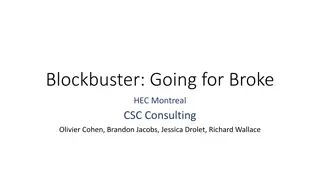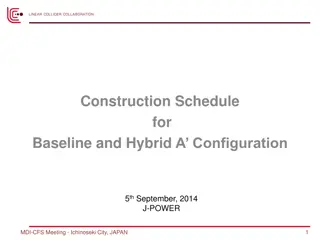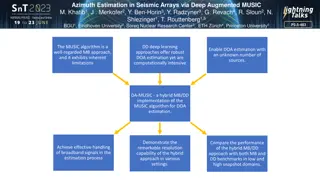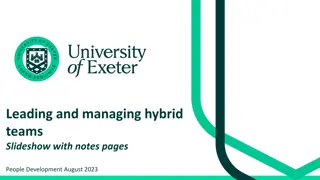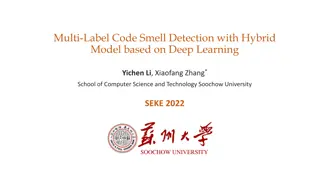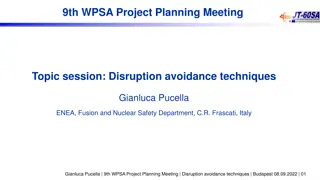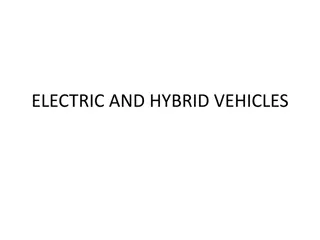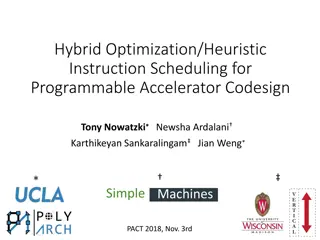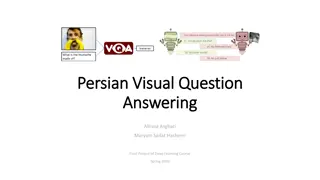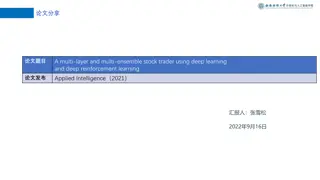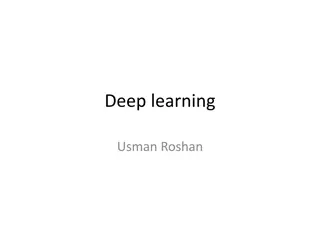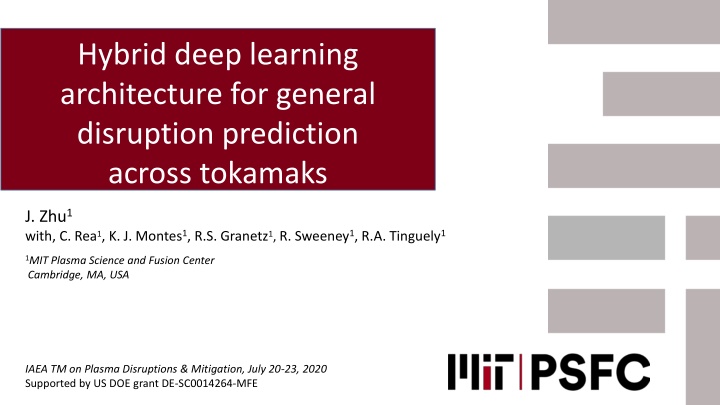
Hybrid Deep Learning Predictor: Revolutionizing Disruption Prediction in Tokamaks
Harness the power of a Hybrid Deep Learning (HDL) architecture for accurate disruption prediction across tokamaks. Explore a new disruption predictor enhancing progress towards ITER requirements. Dive into datasets, predictive models, and cross-machine studies for advanced insights in fusion technology. Gain real-time deployment potential with the fast and powerful HDL Predictor.
Download Presentation

Please find below an Image/Link to download the presentation.
The content on the website is provided AS IS for your information and personal use only. It may not be sold, licensed, or shared on other websites without obtaining consent from the author. If you encounter any issues during the download, it is possible that the publisher has removed the file from their server.
You are allowed to download the files provided on this website for personal or commercial use, subject to the condition that they are used lawfully. All files are the property of their respective owners.
The content on the website is provided AS IS for your information and personal use only. It may not be sold, licensed, or shared on other websites without obtaining consent from the author.
E N D
Presentation Transcript
Hybrid deep learning architecture for general disruption prediction across tokamaks J. Zhu1 with, C. Rea1, K. J. Montes1, R.S. Granetz1, R. Sweeney1, R.A. Tinguely1 1MIT Plasma Science and Fusion Center Cambridge, MA, USA IAEA TM on Plasma Disruptions & Mitigation, July 20-23, 2020 Supported by US DOE grant DE-SC0014264-MFE
New disruption predictor shows progress toward ITER requirements Motivation: ITER cannot withstand many unmitigated disruption [1]. Any predictor for ITER must rely on few disruptive shots from test machine. Our predictor learns device-independent knowledge from disruptive data, while non-disruptive data is machine-specific. Few "unseen" device disruptive discharges still needed to reach best performances [1] De Vries P. C. et al. 2016 Fus. Sci. Technol. 69, 471 484 2
Disruption warning databases Table 1: The dataset composition of the three disruption warning databases Number of training shots Number of test shots Number of validation shots 3343 C-Mod 651 463 (692 disruptive) 5286 (732 disruptive) 8296 (2301 disruptive) DIII-D 1085 734 EAST 1674 1137 label imbalanced datasets Table 2: Signals considered in the development of the predictive models lock-mode-proxy Greenwald-fraction lower-gap z-error-proxy radiated-fraction Rotating-mode-proxy v-loop q95 ip-error-fraction betap kappa li 3
Hybrid Deep Learning (HDL) Predictor: a fast, powerful and general predictive model for disruption The prediction framework consists: An advanced deep neural network converts an input plasma sequence to a predicted label. A shot by shot testing scheme to simulate alarms triggered in the Plasma Control System (PCS). HDL features: Impressive performance on different machines with limited hyperparameter tuning Suitable for cross-machine study and ITER disruption prediction research. Short evaluation time (<1ms using an 8-core CPU), real-time deployment potential. 4
Cross-machine study: explore data-efficient disruption prediction on new devices. Setup: two machines as existing machines , with the third one chosen as a new device . Performance metric: ROC curves and AUC values [2] at 50ms before the current quench. All following qualitative conclusions are machine-independent (only show the EAST case). [2] Bradley A. P. 1997 Pattern Recognition, 30, 1145 1159 5
Best prediction recipe using 20 disruptive training shots from the target new device Best prediction recipe on new device: using a few disruptive shots and many non-disruptive shots from the new device plus many disruptive data from existing devices. Training Set Composition Number of Shots 10000 Best scenario with limited disruptive 100 1 Existing New Machine Disruptive Non-Disruptive 6
Remove all disruptive training shots from the new device, worse Best prediction recipe on new device: using a few disruptive shots and many non-disruptive shots from the new device plus many disruptive data from existing devices. Training Set Composition Number of Shots 10000 100 1 Existing New Machine Disruptive Non-Disruptive 7
Remove 50% of new device non-disruptive shots, worse Best prediction recipe on new device: using a few disruptive shots and many non-disruptive shots from the new device plus many disruptive data from existing devices. Training Set Composition Number of Shots 10000 100 1 Existing New Machine Disruptive Non-Disruptive 8
Trained only on selected new device data, baseline case, much worse Best prediction recipe on new device: using a few disruptive shots and many non-disruptive shots from the new device plus many disruptive data from existing devices. Training Set Composition Number of Shots 10000 100 1 Existing New Machine Disruptive Non-Disruptive 9
Go back to the baseline case Best prediction recipe on new device: using a few disruptive shots and many non-disruptive shots from the new device plus many disruptive data from existing devices. Training Set Composition Number of Shots 10000 Baseline case with limited disruptive 100 1 Existing New Machine Disruptive Non-Disruptive 10
Add disruptive data from existing machines, much better Best prediction recipe on new device: using a few disruptive shots and many non-disruptive shots from the new device plus many disruptive data from existing devices. Training Set Composition Number of Shots 10000 100 1 Existing New Machine Disruptive Non-Disruptive 11
Continually add non-disruptive data from existing machines, drop back Best prediction recipe on new device: using a few disruptive shots and many non-disruptive shots from the new device plus many disruptive data from existing devices. Non-disruptive data from existing devices is harmful while disruptive data is beneficial to the predictive power, might from the label imbalance of each training set. Training Set Composition Number of Shots 10000 100 1 Existing New Machine Disruptive Non-Disruptive 12
Cross-machine experiments using all disruptive training shots from the target new device Training Set Composition Number of Shots 10000 Best scenario with all disruptive 100 1 Existing New Machine Disruptive Non-Disruptive 13
add non-disruptive data from existing machines, worse Training Set Composition Number of Shots 10000 100 1 Existing New Machine Disruptive Non-Disruptive 14
Trained only on new device data, baseline case, worse Disruptive data from existing machines is still beneficial, while non-disruptive data is still harmful even with abundant new device disruptive data. Training Set Composition Number of Shots 10000 100 1 Existing New Machine Disruptive Non-Disruptive 15
Remove 2/3 of EAST non-disruptive training shots, an inversely imbalanced dataset Disruptive data from existing machines is still beneficial, while non-disruptive data is still harmful even with abundant new device disruptive data. Training Set Composition Number of Shots 10000 Baseline case with reduced non-disruptive 100 1 Existing New Machine Disruptive Non-Disruptive 16
add disruptive data from existing machines, better Disruptive data from existing machines is still beneficial, while non-disruptive data is still harmful even with abundant new device disruptive data. Training Set Composition Number of Shots 10000 100 1 Existing New Machine Disruptive Non-Disruptive 17
add non-disruptive data from existing machines, worse Disruptive data from existing machines is still beneficial, while non-disruptive data is still harmful even with abundant new device disruptive data. The effects of disruptive data (positive) and non-disruptive data (negative) do not result from the class imbalance of the dataset. Non-disruptive data is machine-specific, while disruptive data contains general knowledge about disruptions. Training Set Composition Number of Shots 10000 100 1 Existing New Machine Disruptive Non-Disruptive 18
Distributions of non-disruptive signals are clear different across devices Univariate distributions imply different devices tend to have disjoint operational regimes. 19
Different devices show similar behaviors when a disruption is imminent Univariate distributions imply different devices tend to have disjoint operational regimes. Similar behaviors in disrupt data across machines are general knowledge hidden beneath disruptive shots. 20
Summary and Conclusions Summary 1. HDL framework: a powerful general solutions for disruption prediction. 2. Relatively good prediction performances on target devices can be achieved using a small set of disruptive shots while thousands of non-disruptive shots from themselves, plus hundreds of disruptive discharges from other devices. 3. Non-disruptive data is machine-specific, and the disruptive data contains general knowledge about disruptions. 4. Future work: Fine hyperparameter tuning Incorporate device features to the HDL framework Extend analysis to other tokamaks (JET, KSTAR ) 21
Summary and Conclusions For more information See J.X. Zhu, C. Rea et al. Hybrid deep learning architecture for general disruption prediction across tokamaks, submitted to Phys. Rev. Lett., 2020 https://arxiv.org/abs/2007.01401 22



